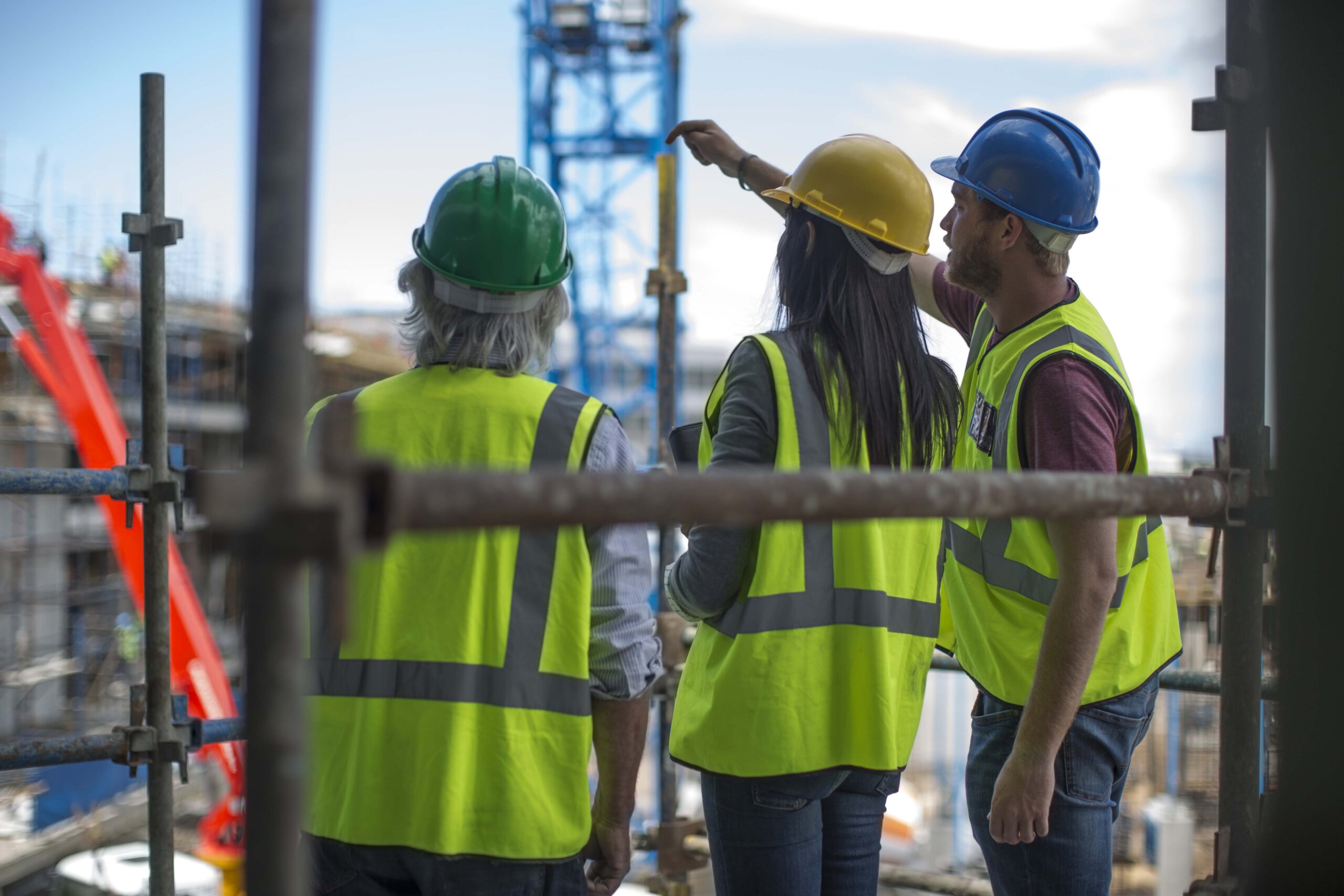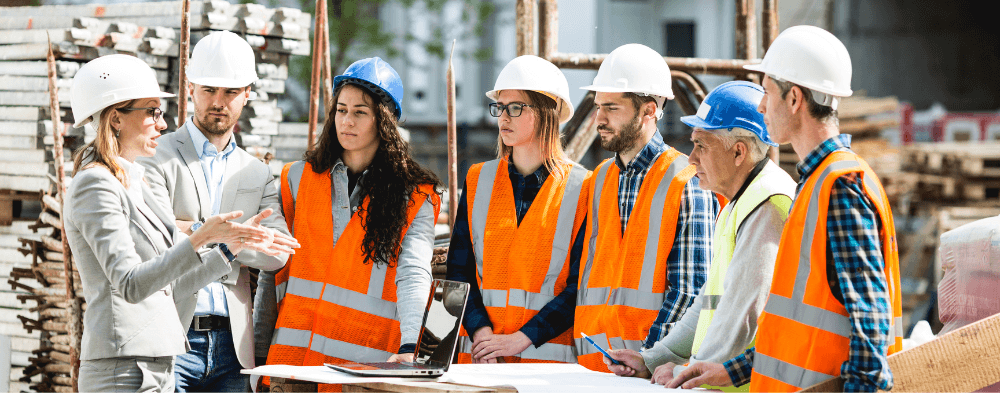“Toolbox talks” have long been a staple of construction safety, but in today’s age of rapidly advancing technology, it’s time to refresh our approach. In this blog post, we’ll explore how to optimize toolbox talks for the modern workplace and how to use them to elevate your jobsite’s safety culture.
We’ll cover topics such as utilizing technology, modernizing safety training, and developing an effective toolbox talk structure. By the time you’re done reading, you’ll have all the tools you’ll need to develop successful, impactful toolbox talks that can help keep your jobsite safe.
What is a Toolbox Talk?
A toolbox talk is a brief safety meeting that provides an opportunity for workers to gather together and discuss potential hazards and safe work practices. Daily toolbox talks are a critical component of maintaining a safe and productive construction site.
There is no legal requirement to conduct toolbox talks in construction, but they are a way to quickly highlight key safety topics in a less formal setting. They are usually lead by a crew foreman or supervisor, but can be lead by anyone, including owners or safety specialists.
The Importance of Daily Toolbox Talks
By conducting daily toolbox talks, you are:
- Demonstrating your commitment to the safety and well-being of your team.
- Reminding workers that safety should always be a top priority on the job.
- Creating a safety culture where everyone is responsible for identifying and mitigating risks.
- Significantly reducing the risk of accidents and injuries on the job.
- Empowering your team to make safer choices and avoid costly accidents
- Addressing potential hazards and reinforcing safe practices on the jobsite.
Regular toolbox talks also serve as a valuable opportunity for information sharing. They allow workers to stay updated on important safety procedures, equipment usage, and any changes to jobsite conditions. This open communication helps to minimize misunderstandings and ensure that everyone is on the same page.
Who Should Be Involved in Toolbox Talks?
To create a strong safety culture on your construction site, it’s crucial to get your entire team involved. When every member of your team is actively engaged in safety practices, accidents and injuries are less likely to occur.
So how do you get your team involved in safety culture?
- Empower your workers to take ownership of safety: Encourage them to participate in toolbox talks by sharing their own experiences, insights, and ideas for improving safety. When employees feel like their opinions and suggestions are valued, they are more likely to actively participate and take safety seriously.
- Fostering open lines of communication: Encourage your workers to speak up if they see any potential hazards or have any safety concerns. Implement a reporting system where employees can anonymously report safety issues or near misses. By creating a safe space for open dialogue, you can build trust and ensure that everyone feels comfortable speaking up about safety matters.
- Involve your team in the development of safety procedures and policies: By allowing them to have a say in safety protocols, you empower them to take ownership and feel more invested in the overall safety of the jobsite.
Remember, getting your team involved in safety culture is a collaborative effort. By valuing their input and actively involving them in safety practices, you create a stronger, more proactive safety culture on your construction site.
Planning Effective Toolbox Talk Topics and Timing
Planning effective topics and timing for your toolbox talks is essential to keep your audience engaged and ensure that the discussions are relevant to their daily work. One approach is to start by identifying the most common safety issues or incidents that occur on your jobsite. These could be specific hazards related to equipment or processes, or general safety practices that need reinforcement. By addressing these topics, you can provide your team with practical information and strategies to prevent accidents.
It’s also important to consider the timing of your toolbox talks. Find a time that works best for your team, such as at the start or end of a shift when everyone is present. Avoid scheduling the talks during peak work hours when your workers may be focused on their tasks. By choosing the right timing, you can ensure that your team is fully attentive and receptive to the safety information being discussed.
Vary the topics of your toolbox talks to keep them fresh and engaging. Cover a range of safety issues to address different aspects of your jobsite’s safety culture. You can include topics such as personal protective equipment, fall prevention, emergency procedures, or even mental health and stress management. By providing a diverse range of topics, you can cater to the specific needs and interests of your team members.
We have compiled a list of 20 toolbox talk topics and talking points for each one, to help you get started.
Effective planning of topics and timing is crucial to ensure that your toolbox talks are impactful and engaging. By addressing common safety issues, scheduling talks at convenient times, covering a variety of topics, and incorporating interactive elements, you can enhance the effectiveness of your toolbox talks and elevate your jobsite’s safety culture.
Consider Interactive Toolbox Talks for Better Engagement
Engaging your audience is crucial for successful toolbox talks. While providing information is important, actively involving your team in the discussion is what truly drives engagement and makes the talks more impactful. One effective way to engage your audience is through interactive talks. Interactive toolbox talks create a dynamic environment where participants are encouraged to actively participate, share experiences, and provide input.
Examples of interactive toolbox talks are demonstrations, role-playing scenarios, and group discussions. These activities allow your team members to actively apply safety principles to real-life situations and share their perspectives. This not only enhances their understanding but also encourages them to take ownership of safety practices.
Interactive talks not only engage your audience but also encourage active participation and the sharing of experiences and ideas. By involving your team in the discussion, you create a more collaborative and inclusive safety culture. Through collaboration and teamwork, your team can learn from each other’s experiences and exchange ideas. By facilitating these discussions, you can tap into the collective knowledge and expertise of your team members, further strengthening your safety culture.
Remember, toolbox talks should be a two-way conversation rather than a one-sided lecture.
Utilizing Technology for Greater Impact
In today’s rapidly advancing technological age, incorporating technology into your toolbox talks can have a significant impact on your jobsite’s safety culture. There are various ways you can utilize technology to enhance the effectiveness and reach of your safety discussions. Examples of this are:
- Multimedia Presentations or Videos: This can help visually demonstrate safety procedures and showcase real-life examples of accidents or near misses. By incorporating visual elements, you can better engage your audience and reinforce key safety messages.
- Virtual reality (VR) and augmented reality (AR): VR can provide immersive and interactive experiences that simulate hazardous scenarios, allowing workers to practice safety procedures in a controlled environment. AR can overlay digital information onto the physical environment, providing real-time guidance and visualizations to help workers identify potential hazards.
- Mobile Apps or Online Platforms: These tools can streamline the process of conducting toolbox talks by providing easy access to safety materials and allowing for digital sign-ins or record keeping. Additionally, they can facilitate real-time communication and collaboration among team members, enabling them to share safety updates or report hazards more efficiently. Construction management software like Corfix can help track your toolbox talks and make them accessible to those who need them. ARCAN, a Corfix customer, had this to say about using online platforms for toolbox talks:
That’s why we’ve gone with an online platform – I’m able to see what the guys are doing almost instantaneously, I can review their toolbox talks, and their hazard assessments across three thousand kilometers.” – Michael Wonderham, EHS Manager, ARCAN [Read more]
By embracing technology, you can not only make your toolbox talks more engaging and interactive but also reach a wider audience. With the use of online platforms or video conferencing tools, you can connect with remote team members or subcontractors who may not be physically present on the jobsite. This inclusivity helps to ensure that everyone receives consistent safety information and promotes a unified safety culture.
Incorporating technology into your toolbox talks is a proactive step towards keeping up with the modern workplace and leveraging the tools available to us. By embracing these advancements, you can maximize the impact of your safety discussions and elevate your jobsite’s safety culture to new heights.
Measuring the Success of Toolbox Talks
Measuring the success of your toolbox talks is essential to ensure that you are effectively improving your jobsite’s safety culture. By using metrics and feedback, you can gather valuable insights that will help you assess the impact of your safety discussions and make any necessary adjustments.
Here are some of the ways you can measure the success of your toolbox talks:
- Observation and Documentation: Take note of any changes in worker behavior or adherence to safety protocols after each talk. Keep track of the number of reported hazards or near misses before and after implementing the talks. This data will provide you with a clear indication of whether your toolbox talks are making a difference.
- Solicite Feedback From Your Team: Ask them about their thoughts on the talks and if they found them helpful. Encourage them to share any suggestions or ideas for improvement. This feedback will not only help you evaluate the effectiveness of your Toolbox Talks but also show your team that their opinions are valued.
- Conduct Regular Safety Audits: Use these safety assessments to evaluate the overall safety culture on your jobsite and determine if your toolbox talks are contributing to a safer work environment.
By measuring the success of your toolbox talks with metrics and feedback, you can continuously improve and refine your safety discussions, ultimately elevating your jobsite’s safety culture.


